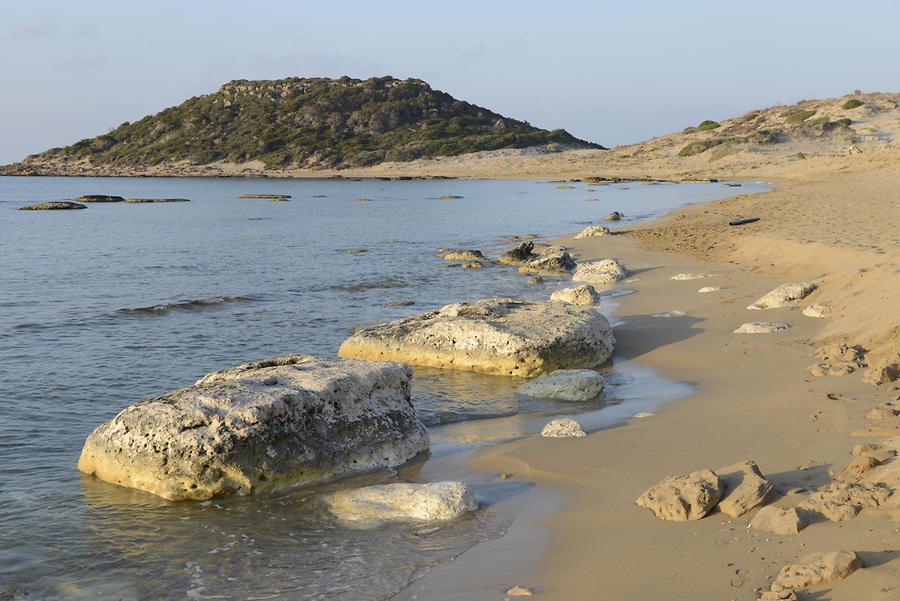Golden Beach#

Golden Beach, August 2016, © Gerhard Huber, under CC BY-NC 4.0 +Edu
The poorer Northern Cyprus, with its even more secluded sandy bays, also relies on tourism, but still depends on Turkish financial aid. The island has not only beautiful coastlines and wild mountain landscapes to offer for the increasing number of tourists, but also plenty of history. It started more than 11,000 years ago when immigrants from Anatolia settled the island for the first time. With the Cretan Minoans the Greek culture came to Cyprus. In the course of time, at least 11 city-states were founded which contested with each other in splendour and prosperity. After a Hellenistic period under the rule of an Egyptian Diadochi state, Cyprus became a Roman province just before the turn of the eras. Starting from the 7th century, restless times dawned. As an apple of discord between Byzantines and Arabs, the island came increasingly under Muslim influence, until 1191 Richard the Lionheart conquered Cyprus and sold it to the Knights Templar. After a long reign of the Catholic Franks and later on the Venetians, the tide was turning in 1571. For more than three hundred years, Cyprus became part of the Ottoman Empire until the Turks leased the island to the British - in return for Britain's help in the fourth Turkish-Russian war. But also with its independence in 1960 no peace came to the island - on the contrary. A civil war between the Greek and Turkish Cypriots ended with the occupation of Northern Cyprus by Turkish troops in 1974. In 1983 the Turkish Cypriots proclaimed the 'Republic of Northern Cyprus', which is recognized only by Turkey. It wasn't until 20 years later that a certain process of rapprochement started with the opening of some border crossings. Today, there are good economic and social contacts between the two parts of the country. The border crossing goes off without a hitch, but a reunion is still a long way off despite many years of negotiations.
Das ärmere Nordzypern setzt mit seinen noch viel einsameren Sandbuchten ebenso auf den Tourismus, bleibt aber trotzdem von türkischer Finanzhilfe abhängig. Für die steigende Zahl an Touristen hat die Insel nicht nur schöne Küsten und wilde Berglandschaften zu bieten, sondern auch eine übergroße Portion an Geschichte. Sie beginnt bereits vor mehr als 11.000 Jahren, als Einwanderer aus Anatolien die Insel erstmals besiedeln. Mit den kretischen Minoern kommt die griechische Kultur nach Zypern. Im Laufe der Zeit entstehen mindestens 11 Stadt-königreiche, die an Pracht und Wohlstand miteinander wetteifern. Nach einer hellenistischen Periode unter Herrschaft eines ägyptischen Diadochenstaates wird Zypern knapp vor der Zeitenwende zur römischen Provinz. Ab dem 7. Jahrhundert brechen unruhige Zeiten an. Als Zankapfel zwischen Byzantinern und Arabern gerät die Insel zunehmend unter muslimischen Einfluss, bis 1191 Richard Löwenherz Zypern erobert und an den Templerorden verkauft. Nach langer Herrschaft durch die katholischen Franken und später die Venezianer wendet sich das Blatt 1571 abermals. Für mehr als 300 Jahre wird Zypern zu einem Teil des osmanischen Reiches, bis die Türken die Insel an die Briten verpachten – als Dank für die Hilfe Englands beim 4. türkisch-russischen Krieg. Doch auch mit der Unabhängigkeit 1960 kehrt kein Frieden ein – im Gegenteil. Ein Bürgerkrieg zwischen den griechischen und türkischen Zyprioten endet 1974 mit der Besetzung Nordzypern durch türkische Truppen. 1983 proklamieren die türkischen Zyprioten die „Republik Nordzypern“, die nur von der Türkei anerkannt wird. Erst 20 Jahre später beginnt mit der Öffnung einiger Grenzübergänge ein zaghafter Annäherungsprozess. Heute bestehen zwischen beiden Landesteilen gute wirtschaftliche und soziale Kontakte. Der Grenzübertritt gestaltet sich problemlos, doch eine Wiedervereinigung lässt trotz jahrelanger Verhandlungen noch auf sich warten.